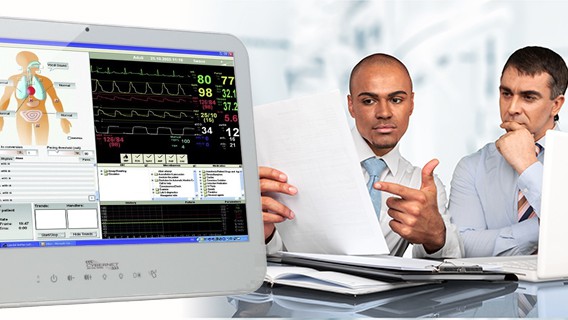Patient data has become the cornerstone of healthcare in recent years. And while the term “data” may immediately conjure up images of computer databases and digital spreadsheets, for quite some time, the healthcare space actually preferred to use physical paper charting in order to record this information. But, if there’s anything we can learn by looking at nearly any industry, it’s that the more technology advances, the more versatile its applications become, and the more reliant we become on it. And the same can be said for healthcare data transcribing tech.
With modern innovations such as medical grade all in one pcs, for example, physicians can now use computers equipped with multiple peripherals and functionalities in order to record patient notes, prescriptions, and identification credentials digitally. Thanks to these and many other advances, there has been quite the push for going paperless in healthcare in order to further improve the way we administer care. Of course, this all sounds convenient in theory, but with any major disruption to a long-held workflow, there are going to be roadblocks.
With that in mind, what does going paperless in healthcare really mean? What are the benefits of making this shift and what are some growing pains the sector might face? Furthermore, what are some initiatives you can take today to ensure your facility isn’t left behind as technology inevitably continues to digitize the healthcare process?
What are the Benefits of Going Paperless in Healthcare?
Article Guide
Going paperless in healthcare can deliver a myriad of benefits that go beyond just being more environmentally conscious. Truth of the matter is, it can improve facility operations across the board.
Efficiency
Optimization is clearly one of the greatest draws to going paperless in healthcare. After all, cutting down on manual scribing and multiple methods of data recording greatly lowers the amount of time spent intaking patient data, time that can then be spent to look after patients.
Opens the Door For Better Care
Data being digitized allows for it to be shared much more readily with other facilities, specialists, and with the patients themselves. This opens the door for initiatives like clinical collaboration, which allows a facility to collaborate with other caregivers who have worked with their patients previously or specialists who can deliver care more tailored to that patient’s condition.
Digitization of data also provides more clarity in the data gathered. In digital pathology, for example, 4K medical displays and scanners provide incredibly high-res scans of patients that can be closely analyzed for diagnoses. Not only that, but because these scans can be shared electronically, it means physicians can send them off in real time and receive input on their findings much quicker, making care that much more responsive.
Enhanced Security
Relying more on digital initiatives and internet connectivity often opens the door to more healthcare industry cybersecurity threats. Fortunately, medical device manufacturers and providers have long since come to understand this and have also done their part to address these concerns.
Several pieces of both hardware and software exist that help alleviate the threat of patient data being stolen. One such example is HIPAA certified messaging apps which allow facilities to share patient data behind barriers such as physician logins. Medical computers that include RFID, biometric scanners, and Imprivata certified authentication hardware also securely lock patient data away behind safeguards such as fingerprint, badge, or even facial scanning.
Why Aren’t We 100% Paperless?
Of course, if paperless healthcare were foolproof, there would be a 100% adoption rate. However, we still see some reservations, and quite a bit of them. In fact, even today, only 1 in 10 NHS trusts are fully digitized. So, what are the roots of those reservations?
Difficulty Using EHR
The switch to electronic health records was one of the largest shifts towards paperless healthcare we’ve seen. Hospitals are required to use these digitized patient records that were supposedly designed to deliver all of the paperless benefits we discussed above. Unfortunately, EHR compatibility and interoperability issues still run rampant, making sharing data across certain EHR software cripplingly difficult.
EHRs also ask for a hefty amount of note taking for billing purposes and, while it may be digitized, physicians still regularly report that they spend 2 hours taking notes for every hour spent looking after a patient. Couple that with the absurd amount of time that’s needed to log into EHR records several dozens of times a shift, and it’s easy to see why people would have a bad taste in their mouths regarding going paperless in healthcare.
Resentment Towards New Workflows
We’re all creatures of habit. The same can be said for doctors and nurses. When a professional spends their entire career using pen and paper and that’s suddenly swapped out with a new workflow, there can be some reservations in learning said workflow.
More often than not, these resentments can be tied back to poor training. Digital innovations are designed to be easy to use. If physicians are finding this isn’t the case with new paperless technology, it’s usually because they haven’t been shown how to use the new hardware in the correct manner.
Addressing These Roadblocks
Fortunately, knowing the main roadblocks to going paperless in healthcare is one of the best steps you can take towards addressing them in your facility. Here are a few best practices.
Create a Comprehensive Training Program
Showing is always better than telling. If you plan on incorporating paperless initiatives, you need to get your staff on board and show them how this new tech can make their workflow easier.
It’s also important to understand that not everyone on your team may have the same level of tech or computer literacy. Training staff in not just how specific tech is used, but in data, analytics, and computer operation basics can help make the transition from pen and paper much less frustrating.
Address EHR Issues Even if There isn’t a Perfect Fix
Interoperability issues across EHRs is, unfortunately, not something you can fix on your own. Until data sharing between different EHR systems is ironed out, all you can do is improve your own internal EHR experiences.
One way to do so is by investing in customized hardware solutions for whatever EHR software your facility uses in order to address EHR physician burnout. If, for example, you work with an EHR software that stores large pages of data and you want to cut down on excessive scrolling, larger monitors can make navigating those pages much easier. Others with software that has them repeatedly logging in several times a day could also benefit from RFID badge scanners that make logging in a much simpler, time-conscious process.
Consolidate Onto One Device
Paperless hardware needs to be easier than breaking out a pen and paper. Otherwise, what’s the point? Making your paperless initiatives simple to use even for those that aren’t tech-savvy will make staff that much more receptive to them.
For instance, if you want to improve your internal prescription practices by eliminating paper prescriptions, invest in easy-to-use hardware such as a medical RFID tablet. The right manufacturer can integrate all of the RFID peripherals into the tablet itself, eliminating the need for external hardware. Furthermore, by scanning into a device with RFID and then writing an electronic prescription that is automatically sent over to the pharmacy, your facility can prevent prescription fraud and error rates.
Going Paperless in Healthcare Requires Working with Your Staff
While going paperless in healthcare is surely the future, special attention needs to be paid in how receptive your staff members, particularly your older staff members, are to these new workflows. Even if it takes a little more time to get these initiatives rolling in your facility, carefully training and going through these shifts step by step with your staff members will make adoption of these paperless initiatives much more stress-free. For more information on the type of hardware that can help make these initiatives a reality, contact an expert from Cybernet today.
How Medical Computers Are Revolutionizing the Healthcare Industry
October 4, 2015
Medical computers manage patients’ information and allow functions like writing & tracking prescriptions, managing patient billing and tracking all aspects of a patient's medical care. Medical computers are…
0 Comments6 Minutes
Have Hospitals Begun Accepting Healthcare Innovation Technology?
June 16, 2020
Despite the constant release of ever-improving pieces of healthcare innovation technology, providers and facilities can be rather averse to adopting these new hardware and software. While there have been more popularly…
0 Comments10 Minutes
You Can't
Learn from a Pop-up
But we can deliver knowledge to your inbox!
We dive deep in the industry looking for new trends, technology, news, and updates. We're happy to share them with you.
Knowledge, News, and Industry Updates Right in Your Inbox




